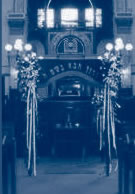|
SEDRA : Emor Hertz Chumash p. 513 Leviticus
Chapter 21
This week's Sedra is generously sponsored by Peter Cohen
OAM and his son David Cohen.
SYNOPSIS:
G-d speaks to Moses to instruct the Kohanim to preserve their
Holy status and the special regulations and precautions they
must take to maintain their purity and perfection. Chief among
these regulations is to avoid contact or involvement with
death and its attendant circumstances. These regulations also
constitute an important source in general for Jewish practise
in death and mourning.
The Kohen may not defile himself to bury the dead among his
people. He was forbidden to attend the funeral of any but
his nearest relatives (father, mother, brother, (unmarried)
sister son, daughter or spouse). Contact with a dead body
or being under the same roof as a dead body rendered him unfit
to perform his priestly duties, these regulations also preclude
a Kohen from marrying a divorcee or convert.The rules governing
the Kohen Gadol - High Priest - were even more restrictive.
He was not to attend any funeral whatsoever, not even his
closest kin, and in addition to the rule for other Kohanim
could marry only a virgin. Kohanim with physical defects were
disqualified from Service in the Sanctuary but were still
entitled to their share in the sacrifices and certain other
priestly benefits. Sacrifices were to be free of any blemish
and animals younger than eight days were not permitted to
be used. Slaughtering an animal and its young on the same
day is not permitted.
The principles of Sanctifying G-d's Name and refraining from
behaviour which bring G-d Israel or Torah into disrepute are
enunciated. The Sedra then introduces a section outlining
the Festivals, their dates and the practises in their observance.
This forms part of the regular Torah reading on Pesach and
Sukkot (the readings on Shavuot relate to the theme of Revelation
and the giving of the Torah). During the year certain days
were proclaimed as a "Holy Convocation". On these
days people were called together to the Sanctuary for communal
worship and all Melakha activities were not permitted. Firstly,
mention is made of the Shabbat, every seventh day of the week.
The first and last days of Pesach, the Feast of Matzot, are
to be observed from the 15th to 21st of the Month of Nisan.
Once the Israelites took possession of their land they were
to present a sheaf - OMER - of the first of the barley harvest
on the 16th of the month.
Shavuot is observed on the 50th day of the continuous counting
from the beginning of the bringing and counting of the Omer
on the 6th Sivan. On Shavuot an offering of two loaves made
from the new wheat harvest was brought to the altar.
Then follows Rosh Hashannah, New Year (counting from the date
of creation) called Yom Teruah, the day of blowing the Shofar
occurring on 1st Tishrei.
Yom Kippur, Day of Atonement is on the 10th Tishrei observed
by fasting, prayer and repentance of sins.
Succot, Tabernacles, is on the 15th Tishrei till the 21st.
This is a time of great rejoicing and the Lulav, Etrog, Hadas
and Arava are taken as a symbol of thanksgiving. During the
Festival Jews dwell in the Succah, recalling G-d's protection
of the Israelites in their wanderings in the wilderness.
The 22nd Tishrei is Shemini Atzeret, observed as a solemn
day of rest. The people are reminded to provide pure olive
oil for the Eternal Lamp - Menorah - in the Sanctuary. Reference
is made to the Showbread - 12 loaves of fine flour set in
two rows symbol of G-d the provider of sustenance to all.
The incident of the blasphemer and his death sentence concludes
the Sedra.
HAPHTORAH HERTZ CHUMASH P.528 Ezekiel Chap. 44 : 15
The haphtorah describes the vision of the prophet Ezekiel
(who lived after the destruction of the first Temple) of the
New Jerusalem and its Reconstructed Temple. The prophet describes
the role of the Kohanim in the new Temple which is the link
between the Sedra and the Haphtorah.
TELL ME RABBI ..... CHOIR (Heb. Makhelah)
Choral singing is probably based on the phrase in Psalm 68,
"Bless ye G-d in full assemblies." In Temple worship
the Levite choir consisted of a minimum of twelve adult male
singers, from the age of thirty after having been trained
for five years. After the destruction of the Second Temple
in C.E. 70 the Levite choir ceased to function. Both vocal
and instrumental music were banned as a sign of national mourning.
Maimonides however, permitted the choir to sing at synagogue
services and at all religious feasts a capella since instrumental
music has continued to be forbidden.
In the early centuries "Tomekhim" (supporters) assisted
the "Precentor" (Cantor) as promoters and musical
assistants. As time when on, the "bass" and the
"singer" in the Ashkenazic synagogue served as "Unterhalter"
(supporters) to the precentor and supplied harmonic accompaniment
in an improvisatory manner.
This "Hazzan-Bass-Singer" arrangement lasted as
late as the early nineteenth century. In Adrianople (Edirne),
Turkey, a choral group called the Maftirim Choir flourished
from the seventeenth century on. It sang "piyyutim"
(religious poetry) every Sabbath morning at dawn and was known
for nurturing a great number of cantors and assistant singers
("maftirim" or "mezammrim").
Hazzanim such as Isaac B. Solomon Algazi (1882-1964) often
sang as choristers in the Maftirim Choir, a circumstance that
also made Adrianople a center for hymn writing. Other flourishing
singing societies were the Shomerim Laboker (Watchmen of the
Morning), in Italy, and Mezamre Barukh She'amar (Singers of
Barakh She'amar), in Prague.
With the encouragement of the Chief Rabbi of the Republic
of Venice, Leone da Modena, Solomon Rossi (c. 1570 - c. 1630)
organised a choir that sang arrangements of psalms in three
to eight voices. Although Israel Lovy (1773-1832) is credited
with being the first to institute four-part choir singing,
it was Salomon Sulzer (1804-1890) of Vienna whose choir practices
and a musical service met with real success.
"Once, and once only, has it happened to us, as it were,
to catch a glimpse and overhear what a Jewish art might become
..... Rarely has it happened to us to be attacked by so lively
an emotion ... (Franz Liszt). Among those who followed Sulzer
were Louis Lewandowski, in Berlin; Samuel Naumbourg, in Paris;
Hirsch Weintraub, in Konigsberg; Israel Lazarus Mombach, in
London; Eliezer Mordecai Gerovitsch, in Rostov; David Nowakowsky,
in Odessa; and Boruch Schorr, in Lemberg (Lvov).
In the United States four-part choir singing was introduced
by Jacob Samuel Maragowsky and Abraham Frachtenberg. In the
early twentieth century this practice was perpetuated by Herman
Wohl, Jacob Margulies, and Meyer Machtenberg and in Poland
by David Eisenstadt, Yitzhak Schlossberg, and Avraham Zvi
Davidovitz. Since the middle of the twentieth century there
has been a decline in the use of professional choirs.
The lengthened service required for choral singing rather
than passive listening has become the vogue. Interest in synagogue
musicianship as a vocation or avocation has decreased. Nonetheless,
numerous synagogues throughout the world still engage volunteer
choir singers for the High Holy Days.
BACK TO SHABBAT SHALOM
TABLE
|








